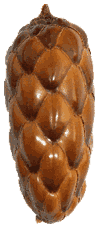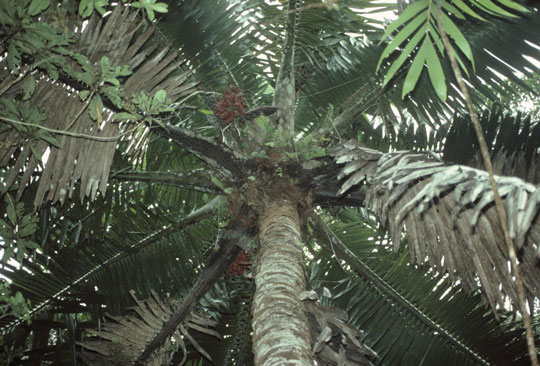 |
Palm |
 |
Palm |
 |
| The crown of Voanioala gerardii in habitat. Photo by J. Dransfield. |
Voanioala gerardii is restricted to tropical rain forest on hills surrounding the Bay of Antongil in northeastern Madagascar; it is known from very few small populations, sometimes from scattered juvenile plants. It occurs on steep slopes and in valley bottoms, at an elevation of approximately 200–450 m above sea level. Sightings from near Toamasina need proper confirmation.
It is a massive palm of the forest canopy, with solitary stems to 15–20 m tall and c. 35 m diameter. The stems are distinctively “stepped,” marked with the protruding remains of the leaf bases. The crown is composed of about 15–20 leaves, each up to about 5 m long, with no petiole and about 70 crowded, regularly arranged leaflets. The inflorescence is produced between the leaves, and arches through the leaf sheaths, to about 1.5 m long. The second bract of the inflorescence is thick, woody and deeply grooved, and encloses the flowers in bud, then splitting longitudinally. The flower bearing branches are numerous (approximately 60) and bear both male and female flowers. The male flowers have 12 stamens. The fruit is 7–8 × 4–5 cm. bright red-brown at maturity. Inside the outer wall of the fruit lies the endocarp, extremely thick and woody, deeply grooved outside and with irregular protuberances on the inside that penetrate the seed. There are three distinctive pores at the basal end of the endocarp. The endosperm is homogeneous and the embryo basal.
Little is known about the natural history of the species. Ripe fruit accumulate in large numbers under trees (unless harvested by seed collectors) suggesting that there is little if any effective dispersal.
The forests where the palm occurs in Masoala are largely included within the Parc National de Masola, Despite this, seed collectors harvest seeds, and three of the ca. 10 mature trees known at the type locality were felled for palm heart in 2003, and only one mature palm was seen. All other populations comprise fewer than ten individuals.
Apart from the inclusion of the habitat within protected areas, there are no current specific conservation measures.
A demographic study of the palm should be performed, and the species should also be searched for elsewhere. A population genetic study would be of great value to ascertain the long-term viability of the populations.
Dr. John Dransfield, Herbarium, Royal Botanic Gardens Kew, Richmond, Surrey, TW9 3AE, UK (j.dransfield@kew.org)
Mijoro Rakotoarinivo, c/o Kew House, Lot II J 131 B, Ambodivoanjo Ivandry Antananarivo 101, Madagascar
Dransfield, J. 1989.
Voanioala (Arecoideae: Cocoeae: Butiinae), a new palm genus from Madagascar.
Kew Bull. 44(2): 191–198.
Dransfield, J. & H. Beentje. 1995.
Palms of Madagascar.
Royal Botanic Gardens, Kew.
Dransfield, J, H. Beentje, A. Britt, T. Ranarivelo & J. Razafitsalama. 2006.
Field Guide to the Palms of Madagascar.
Kew Publishing, Royal Botanic Gardens, Kew.
Dransfield, J, H. Beentje, A. Britt, T. Ranarivelo & J. Razafitsalama. 2006.
Torolalan’ireo Satrapotsy (Palmier) eto Madagasasikara.
Kew Publishing, Royal Botanic Gardens, Kew.